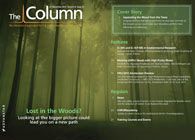A sting in the tale
Two novel peptides have been identified within the crude extract of Asian scorpion Buthus martensi Karsch venom using two-dimensional high perfomance liquid chromatography (2D-HPLC) and tandem mass spectrometry (MS?MS).

Two novel peptides have been identified within the crude extract of Asian scorpion Buthus martensi Karsch venom using two-dimensional high perfomance liquid chromatography (2D-HPLC) and tandem mass spectrometry (MS–MS). Historically used in Chinese medicine to treat heart disease, the venom has potential applications in the development and identification of new drugs. Earlier this year, a study was published showing that peptides isolated from scorpion venom had anti-bacterial properties, specifically effective against established antibiotic‑resistant bacteria.1
Scorpion venom is a complex mixture of proteins, including a range of neurotoxic peptides that selectively block cell-to-cell signalling by selectively binding to ion-channels. These peptides can be used in pharmocological studies to block specific channels and signalling, potentially revealing new drug targets.
Based on genetic data, within the Buthus martensi Karsch venom it is estimated that there are 86 toxins, but only the presence of 46 peptides have been confirmed.2 The previous methods have been regarded as too low a sensitivity to detect all the petides present.
A group of investigators in China2 has identified two novel peptides, previously predicted to be present in scorpion venom-based on genetic data, but otherwise not found. Offline orthogonal two‑dimensional reversed-phase liquid chromatography/hydrophilic interaction liquid chromatography (2D-RPLC/HILIC) purification and collision-induced dissociation tandem mass spectrometry (CID-MS–MS) technique was used. Using bioinformatics the two novel peptides were predicted to be selective inhibitors of the potassium channel toxin α-KTx17 subfamily.
This research therefore has the potential to advance drug development through the discovery of new drug targets.
1. L. Cao et al., PLoS ONE, DOI:10.1371/journal.pone.0040135 (2012).
2. J. Xu et al., Proteomics, 12,3076–3084 (2012).
This story originally appeared in The Column. Click here to view that issue.
Regulatory Deadlines and Supply Chain Challenges Take Center Stage in Nitrosamine Discussion
April 10th 2025During an LCGC International peer exchange, Aloka Srinivasan, Mayank Bhanti, and Amber Burch discussed the regulatory deadlines and supply chain challenges that come with nitrosamine analysis.











